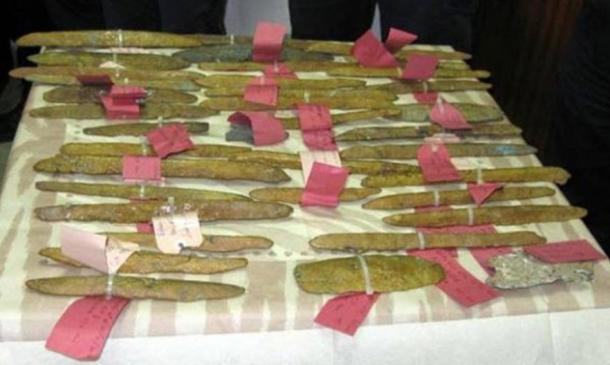Guest
Guest
 |  Subject: Rare orichalcum metal said to be from the legendary Atlantis recovered from 2,600-year-old shipwreck Subject: Rare orichalcum metal said to be from the legendary Atlantis recovered from 2,600-year-old shipwreck  Thu Jan 08, 2015 7:09 am Thu Jan 08, 2015 7:09 am | |
|  8 JANUARY, 2015 - 11:34 APRILHOLLOWAYRare orichalcum metal said to be from the legendary Atlantis recovered from 2,600-year-old shipwreckA team of marine archaeologists have discovered several dozen ingots scattered across the sandy sea floor near a 2,600-year-old shipwreck off the coast of Sicily. The ingots were made from orichalcum, a rare cast metal which ancient Greek philosopher Plato wrote was from the legendary city of Atlantis. According to Discovery News, a total of 39 ingots (metal cast into rectangular blocks) were found close to shipwreck that was discovered in 1988 lying in shallow waters about 300 meters (1,000ft) off the coast of Gela in Sicily.Sebastiano Tusa, Sicily’s superintendent of the Sea Office, told Discovery News that the precious ingots were probably being brought to Sicily from Greece or Asia Minor. 8 JANUARY, 2015 - 11:34 APRILHOLLOWAYRare orichalcum metal said to be from the legendary Atlantis recovered from 2,600-year-old shipwreckA team of marine archaeologists have discovered several dozen ingots scattered across the sandy sea floor near a 2,600-year-old shipwreck off the coast of Sicily. The ingots were made from orichalcum, a rare cast metal which ancient Greek philosopher Plato wrote was from the legendary city of Atlantis. According to Discovery News, a total of 39 ingots (metal cast into rectangular blocks) were found close to shipwreck that was discovered in 1988 lying in shallow waters about 300 meters (1,000ft) off the coast of Gela in Sicily.Sebastiano Tusa, Sicily’s superintendent of the Sea Office, told Discovery News that the precious ingots were probably being brought to Sicily from Greece or Asia Minor.2,600-year-old shipwreck found off the coast of Sicily Tusa said that the discovery of orichalcum ingots, long considered a mysterious metal, is significant as “nothing similar has ever been found.” He added, "We knew orichalcum from ancient texts and a few ornamental objects.”The name orichalucum derives from the Greek word oreikhalkos, meaning literally "mountain copper" or "copper mountain". According to Plato’s 5th century BC Critias dialogue, orichalucum was considered second only to gold in value, and was found and mined in many parts of the legendary Atlantis in ancient timesPlato wrote that , the three outer walls of the Temple to Poseidon and Cleito on Atlantis were clad respectively with brass, tin, and the third, which encompassed the whole citadel, "flashed with the red light of orichalcum". The interior walls, pillars and floors of the temple were completely covered in orichalcum, and the roof was variegated with gold, silver, and orichalcum. In the center of the temple stood a pillar of orichalcum, on which the laws of Poseidon and records of the first son princes of Poseidon were inscribed. (Crit. 116–119) The orichalucum ingots found off the coast of Gela in Sicily. Credit: Opinión Bolivia For centuries, experts have hotly debated the metal’s composition and origin. According to the ancient Greeks, orichalcum was invented by Cadmus, a Greek-Phoenician mythological character. Cadmus was the founder and first king of Thebes, the acropolis of which was originally named Cadmeia in his honor.Cadmus, the Greek mythological figure who is said to have created orichalcum (Wikipedia) Orichalcum has variously been held to be a gold-copper alloy, a copper-tin, or copper-zinc brass, or a metal no longer known. However, in Vergil's Aeneid it was mentioned that the breastplate of Turnus was "stiff with gold and white orachalc" and it has been theorized that it is an alloy of gold and silver, though it is not known for certain what orichalcum was.The breast plate of Turnus was said to be made with gold and white 'orachalc’' 'The Fight between Aeneas and King Turnus' by Giacomo del Po, Italy, Naples, 1652-1726. (Wikimedia Commons) Orichalcum is also mentioned in the ‘Antiquities of the Jews’ (1st century AD) - Book VIII, sect. 88 by Josephus, who stated that the vessels in the Temple of Solomon were made of orichalcum (or a bronze that was like gold in beauty).Today, some scholars suggest that orichalcum is a brass-like alloy, which was made in antiquity the process of cementation, which was achieved through the reaction of zinc ore, charcoal and copper metal in a crucible.The latest discovery of the orichalcum ingots that had laid for nearly three millennia on the sea floor may finally unravel the mystery of the origin and composition of this enigmatic metal.Featured image: Artist’s depiction of the sunken city of Atlantis. Source: FotoliaBy April Hollowayhttp://www.ancient-origins.net/news-history-archaeology/rare-orichalcum-metal-shipwreck-legendary-atlantis-020158 |
|





